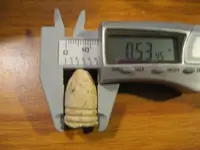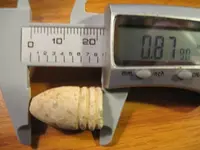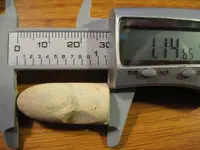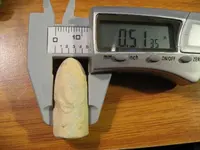Important note:
Please let me correct a misunderstanding held by some diggers about the term "caliber" when it is used in regard to projectiles. Caliber does not mean the same thing as diameter.
Therefore, Old Stonewall's .5135"-diameter bullet is not a ."51-caliber" bullet.
As you probably already know, bullets made for use in Muzzleloader firearms have to be a bit smaller in diameter than the firearm's bore-diameter, in order for the soldier to be able to load the firearm from the gunbarrel's front end, especially after its bore has gotten somewhat clogged with powder-ash after being fired repeatedly. For example, bullets for a .58-caliber Springfiled rifle typically measure somewhere between .560" and .572" in diameter.
Sidenote:
But with Breechloader firearms, the bullet goes into the barrel from the back end ...so, in general, bullets for Breechloaders are actually a little larger in diameter than the bore's diameter. For example, a .52-caliber Sharps bullet typically measures about .54-inch in diameter.
Old Stonewall's .5135"-diameter bullet was manufactured for use in a .54-caliber rifle. (Such as, a .54 Mississipi rifle or a .54 Austrian rifle.) During the second half of the war, due to the frequently-occurring problems CS soldiers were having with "slightly mis-cast" and "oversized" bullets, the Confederate Ordnance Department changed the size-specifications for large-caliber bullets. An order was issued that they be deliberately manufactured about .01" smaller in diamter than in prior years. Old Stonewall's .5135"-diameter bullet is a result of that order.
Now, about its specific ID:
As I indicated in the text above, it is an "Enfield pattern" minie for a .54 Mississippi rifle or .54 Austrian rifle. Old Stonewall's minie is a latter-war version which is very rarely found in Virginia sites ...but is quite commonly found in "Western Theater" sites ...such as the Atlanta Campaign. (I dug hundreds of them there.) So, the field-recovered evidence (dig-locations, and also, being found in large quantities) strongly suggest these somewhat-undersized .54 "Long Enfield" minies were manufactured at a Deep South major Confederate arsenal, located either in Georgia or Alabama. Likely possibilities are Atlanta GA, Macon GA, or Selma AL.
Relevant to the statement above, I should also mention that the specific version of .54 "Long Enfield" minie found by Old Stonewall was made by a bullet-pressing machine, instead of being cast in a bulletmold. Only the major CS arsenals possessed a bullet-press machine ...because such machines were difficult to produce, and therefore were much rarer in the wartime South than they were in industrialized Yankeeland.
Old Stonewall, your specific version of .54 "Long Enfield" minie (there are other versions) is shown in two "updated" civil war bullet-books:
bullet #143A (diameter .519", length 1.12") in "A Handbook Of Civil War Bullets & Cartridges" by James E. Thomas and Dean S. Thomas.
bullet #287 (diameter .519", length 1.15") in "Roundball To Rimfire: A History Of Civil War Small Arms Ammununition, Part Four" by Dean S. Thomas.







